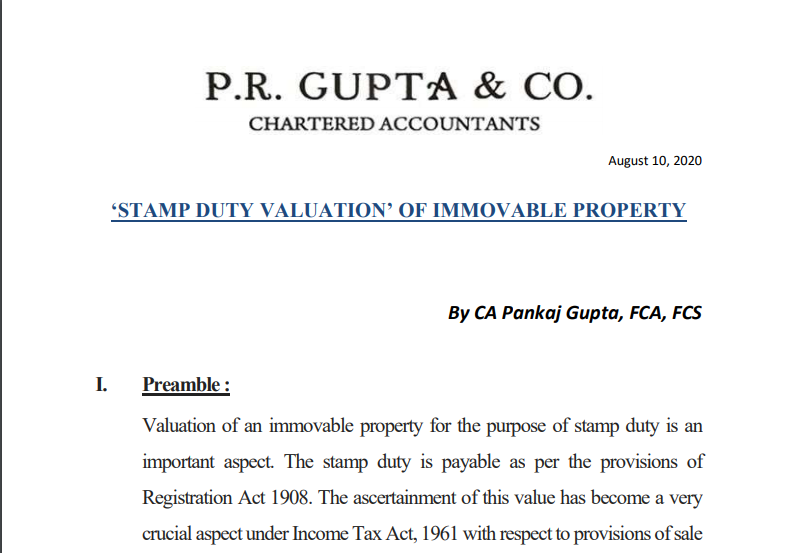Stamp Duty Valuation of Immovable Property
Stamp Duty Valuation of Immovable Property
I. Preamble:
Valuation of immovable property for the purpose of stamp duty is an important aspect. The stamp duty is payable as per the provisions of the Registration Act 1908. The ascertainment of this value has become a very crucial aspect under the Income Tax Act, 1961 with respect to provisions of sale and purchase of the immovable property.
Till now there were three main sections relevant for ‘stamp duty value’. Section 50C, a well-known section impacted the seller and was for calculating capital gains under section 48 in accordance with stamp duty value. The other lesser one known was section 43CA provided for similar provisions for adoption of stamp duty value where the land and building is not held capital asset but is kept as stock-in-trade. Still lesser know is section 56 which impacted the buyer. Now from the assessment year 2021-22, a further proviso has been added in sub-clause (ii) of clause (b) of sub-section (2) of section 55 of the Income Tax Act, 1961, whereby it has been provided that ‘Fair Market Value’ of property as on 1.4.2001 shall not exceed ‘stamp duty value’ as on 1.4.2001 wherever available.
Related Topic:
The frustration of the contract under section 56 as the agreement has become impossible to perform should be appropriately invoked.
II. Value for the Purpose of ‘Stamp Duty’:
As per Registration Act, 1908, value for stamp duty or ‘stamp duty value’ of immovable property at the time of transfer is the ‘value as per ‘circle rates’ prescribed by the Registration Authority of a town or city, etc. responsible for the registration of transfer of such property under its jurisdiction or the actual consideration stated in the agreement for the sale of the property whichever is higher.
The ‘circle rates’ are the rates prescribed by the Registration Authority at which minimum valuation will have to be made necessarily while paying the stamp duty. Say circle rate for land has been prescribed Rs.20,000 per sq. meter, then while transferring a plot of 100 sq. meter where there is no construction, the minimum value on which stamp duty is payable will be Rs.20 lacs. If the stated consideration is 15 lacs, then stamp duty value be taken as 20 lacs. However, if the stated consideration is say Rs. 25 lacs, then the value for the purpose of paying stamp duty shall be Rs. 25 lacs. i.e higher of two amounts.
The circle rates are similarly prescribed for the construction also separately. So if a building is being transferred, then circle rates of land will be applicable to land area and circle rates of construction will be applicable to the built-up area of the construction. A third category is that of flats on a plot of land or a society. Here along with the built-up area, some common areas will also be transferred. This is called the ‘Super Area’. The circle rates prescribed for flats will be calculated by multiplying the super area with the circle rates prescribed. The circle rates vary from locality to locality and also depend upon the floor and other amenities available in a society.
III. Capital Gains calculations :
When a property is being sold, capital gains need to be worked out. As per section 48 of the Income Tax Act, 1961, the capital gains are arrived at by reducing the cost of acquisition from the full value of the consideration received or accruing as a result of the transfer. In this article, the focus is on stamp duty valuation and not on the other intricacies of capital gains which are endless in nature.
Now as per section 50C of Income Tax Act, 1961, it has been provided that where the full value of the consideration received or accruing is less than the value adopted, assessed or assessable by “stamp valuation authority”, the full value of consideration will be deemed to be the value at the time of transfer as per stamp valuation authorities and capital gains will be calculated accordingly by taking this deemed value as sale consideration.
However, the following points/exception may be noted:
a) Where before the execution of sale deed, an agreement to sell has been made, then the stamp duty valuation shall be made by taking circle rates applicable at the time of entering into the initial agreement to sell provided some consideration has passed at the time of agreement by way of account payee cheque or some other electronic mode.
b) Where the ‘stamp duty value’ does not exceed 110% of the stated consideration (earlier up to the assessment year 2020-21 it was 105%), then stated consideration can be taken for calculating capital gains. Say stated consideration is 50 Lacs. Then as long as the stamp duty value does not exceed 55 Lacs, the stated consideration of 50 Lacs can be adopted ignoring the stamp duty value. However, if the stamp value is say 55.10 Lacs, then no benefit shall be given and capital gains will have to be computed with reference to 55.10 lacs.
IV. Implications for Seller:
If a sale deed is being executed, where stated consideration is less than the stamp duty valuation and the margin is more than 10% as discussed above, then the seller can save his skin by paying tax on capital gains by taking sale consideration as per stamp duty value instead of stated consideration.
Where stamp duty value is higher by10% of stated consideration and seller choose to go ahead and declare capital gains with stated consideration, then the following recourse is there for him:
i. The seller will have to challenge the stamp duty value before the relevant stamp duty authorities/ courts.
ii. Otherwise where no appeal/dispute before authorities or courts as regard stamp duty value is pending, then the assessing officer at the time of any proceedings, will refer to the Valuation Officer under section 55A of the Act and assessing officer will proceed according to the value assessed by the valuation officer and same will be binding. However if the value arrives at by the valuation officer is more than stamp duty value, then stamp duty value shall be taken by assessing officer.
If the seller is unable to succeed, then he will have to pay capital gains tax w.r.t stamp duty valuation amount being the deemed sale consideration and also bear other consequences such as interest or penalty and even prosecution in some cases.
V. Implications for Buyer:
Further, in a case where the difference of margin is more than 10%, there will be deeper trouble for the purchaser. In such cases, the difference in stamp duty value and the stated consideration will be treated as income from other sources in the hands of the purchaser under section 56 of the Act. Therefore purchaser will be liable to pay tax on such notional income. If he does not disclose this as income in his return, he will be liable to tax, interest, and penalties. The only recourse will be to challenge in higher courts and that will be a tough call.
VI. Fair Market Value as on 01.04.2001:
Another important aspect is ascertaining the ‘Fair Market Value’ (FMV) as on 1st April 2001. This is in view of the fact that as per section 55 of the Act, the FMV as on 1.4.2001 can be substituted for the cost of acquisition where a property has been acquired before 1st April 2001. The benefit of indexation is also accorded in such cases. So while calculating capital gains, firstly FMV as on 1.4.2001 will arrive and thereafter indexation is done and then the indexed cost is reduced from the sale consideration. The benefit is also accorded to a donee, where the donor has given the gift of the property after 1.4.2001 but the donor had purchased the property before 1.4.2001. Similarly, the benefit shall be available in case a person who has inherited the property from a person who has died after 1.4.2001 but the deceased had acquired it before 1.4.2001.
Now from the assessment year 2021-22, this FMV as on 1.4.2001 should not exceed the ‘stamp duty value’ of such property as on 1.4.2001. It has been clarified under section 55 of the income tax act that ‘stamp duty value’ means value adopted or assessed or assessable by any authority of Central Government or State Government for the purpose of payment of stamp duty in respect of the immovable property. This can lead to some confusion as follows.
Say there is a flat of 1500 sq ft. say ‘A’, of which FMV as on 1.4.2001 needs to be determined. In 1.4.2001, the circle rate of flats in that area was Rs. 1000 per sq ft. So value as per circle rate is 15 Lacs. However, another flat says ‘B’ at that time was registered at say 20 Lacs. Therefore stamp duty value assessable on which stamp duty is payable would be Rs. 20 Lacs.
So a question arises whether the assessee can adopt the FMV as 20 Lacs? Though strict construction of the provisions can lead to a conclusion that this value can be taken since the new proviso in sub-clause (ii) of clause (b) of subsection (2) of section 55 of the Income Tax Act, 1961 speaks of ‘stamp duty value’ and not ‘value as per circle rate’. And ‘stamp duty value’ in turn is the value as per circle rates or actual consideration whichever is higher.
But there seem to be lacunae in drafting the provision and assessee may not be entitled to take that benefit and the value should be determined as per circle rates only i.e value should be 15 lacs. Otherwise, the purpose of bringing this proviso will be defeated and the income tax department can raise a dispute in this regard.
The other problem arises, where the circle rates are not prescribed. In that case, preferably a valuation report should be obtained from a ‘Registered Valuer’ (registered as per wealth tax act) in respect of the FMV as on 1.4.2001. In the absence of circle rates, he can probably go with the average value of a property that has been registered in that area during that time and keeping in consideration other relevant factors or chooses any other method which is fair and represents the true fair market value of the property.
VII. Conclusion:
1) The ‘stamp duty value’ as contemplated under the income tax act is normally understood as the value based on circle rates. Whereas it is the value adopted, assessed, or assessable by the relevant Govt. Authority. Now as already discussed, the registration authorities also take the higher of the two values i.e value as per circle rates and value as stated in the instrument of transfer/ sale deed. So the stamp duty value is different than value as per circle rates.
2) This interpretation of ‘stamp duty value’ which means ‘stamp duty value’ and not ‘value as per circle rates’, can lead to adopting a higher value than the circle rate value in case of arriving value as on 1.4.2001 under section 55 of the income tax act as explained above. This is debatable and the Income-tax department should come out with a clarification in this respect.
3) There is a genuine difficulty for Seller and Buyer where the fair market value is below the Circle Rate value i.e more than 10% margin. There are cases where circle rates have been reduced sometimes but not a common phenomenon. In fact, during this Lockdown and overall property situation, the Government should have pro-actively reduced the circle rate or increase the margin of 10% by way of notification or a special ordinance.
4) Seller and Purchaser should be both careful while complying with these valuation requirements and fully aware of the consequences arising thereof by not following them inadvertently.
Disclaimer:
(These are authors’ personal views for educational purposes and the reader is advised to consult his Consultant/Adviser in case of any clarification or further guidance. No portion of this article can be quoted or reproduced or used in any manner for any purpose without the permission of the author. No responsibility can be attributed to the author in any manner.)
Read the Copy:
If you already have a premium membership, Sign In.
 CA Pankaj Gupta
CA Pankaj Gupta
Mr. Pankaj Gupta is a Fellow Member of the Institute of Chartered Accountants of India (ICAI) and also Fellow Member of The Institute of Company Secretaries of India (ICSI). He has his own CA practice at Noida under the Firm Name “ P.R. Gupta & Co.” and has over 40 years of professional experience dealing in Direct Taxes, Indirect Taxes, Corporate Laws, and FEMA Laws, etc. Clientele includes Non-Residents Individuals and corporate entities. He has remained office-bearer of many professional organizations like ICAI, ICSI, Noida Management Association. He has been instrumental in organizing various professional seminars and has been a speaker at various forums and contributing professional Articles.












